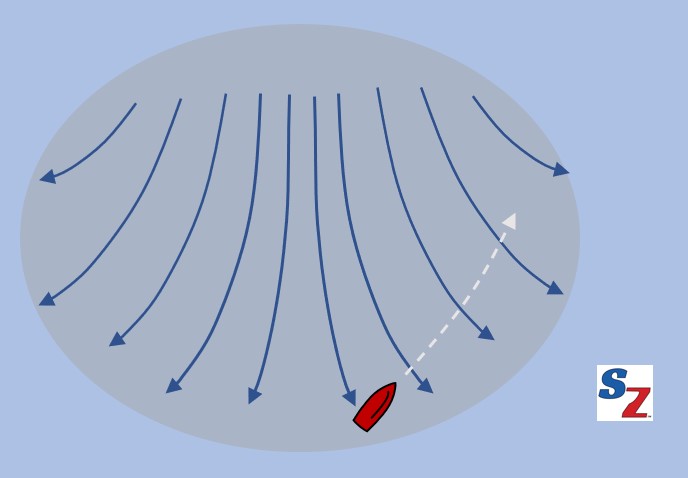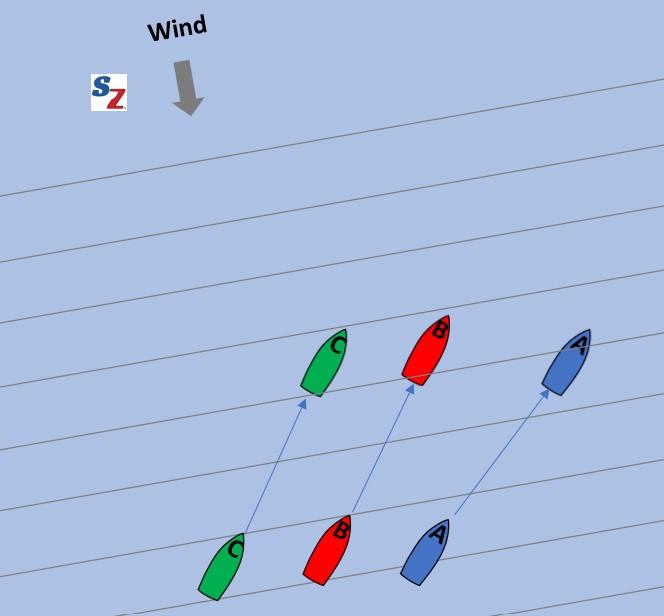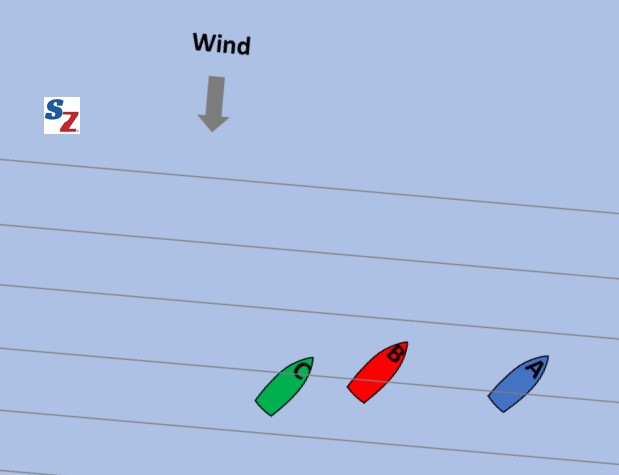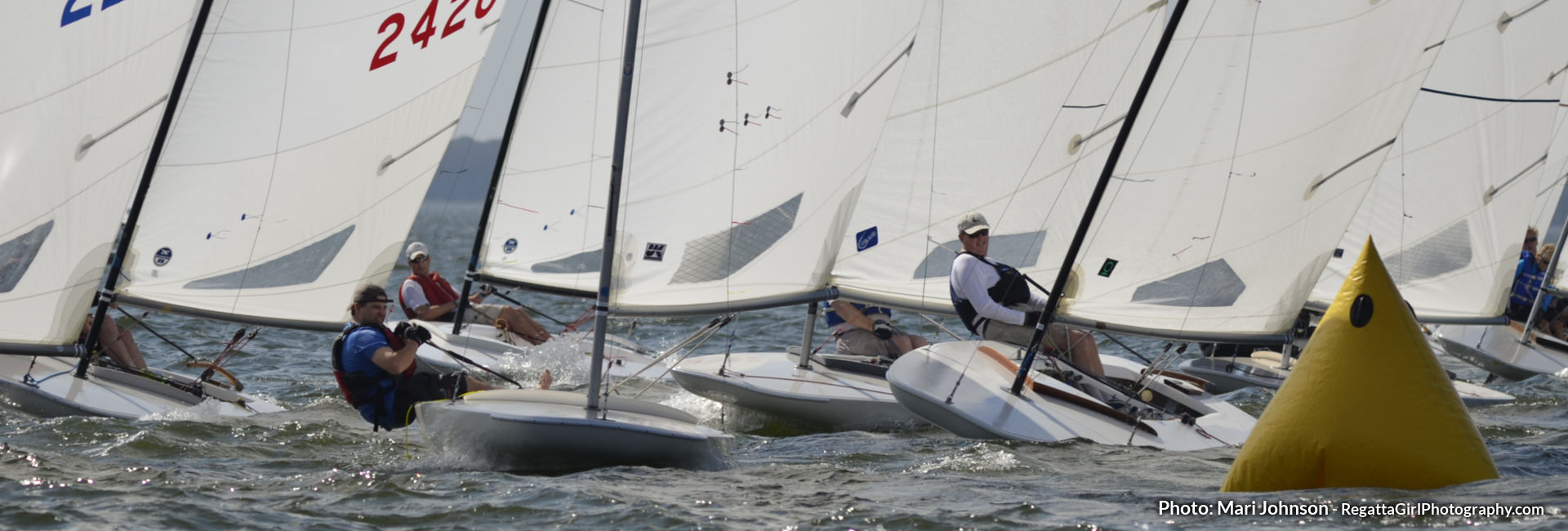How do you use gears tactically? In our post Learn to Change Gears, we discussed three primary gears to manage boat speed for the conditions: VMG gear for most conditions, footing gear to accelerate or in waves, and pointing gear in flat water when you’re up to speed.
While gears help manage boat speed, top sailors also use gears tactically, positioning their boats to maximize gains or minimize losses, both upwind and downwind. To learn about this topic, we reviewed available sources (listed in Related Content) and had a conversation with some top sailors, including a former Olympian.
Two Ways to Use Gears Tactically
Use gears for positioning to achieve two goals: 1) get the most out of puffs and 2) manage separation between boats. In short:
- To get the most out of puffs, use point or foot gears to get to the lifted side of the puff and stay in it longer.
- To manage separation between boats in an oscillating breeze, foot in a lift and point if you’re forced to sail in a header.
#1. Get the Most Out of Puffs
In The Spectrum of the Wind we learned the value of using gusts (puffs):
- May boost wind speed by 30-40%.
- Fan out like a cat’s paw when they initially hit the water. As the drawing shows, each side of the gust will be a lift for boats on one tack and a header for boats on the opposite tack.
- Can remain on the water, moving downwind for as long as 2-4 minutes until they decrease to the average wind speed.
If you had the opportunity to sail in 30% stronger winds on a lift for two-four minutes, you’d certainly want to take advantage of it. Here are things to consider:

Your goal is to sail up the lifted side of the cat’s paw and stay in it as long as possible.
- Point or foot to enter the puff on the bottom edge on the tack that will be lifted.
- Once in the puff, point or foot to stay in the puff on the lifted edge.
- These techniques work for both upwind and downwind sailing.
#2. Manage Separation
Roble/Shea call this technique “tactical moding.” The term “moding” simply means sailing in different gears. The rule of thumb is “foot in a lift and point in a header.”
This tactical play assumes the wind is oscillating slowly enough (every 5-10 minutes) to allow gains from separation. It also assumes that the boat sails somewhat faster when footing than in VMG gear. Here’s how it works:
Foot in a Lift – Lead to the Next Shift
In an oscillating breeze, the winning strategy is to play the shifts: sail the lifts and tack on the headers to reduce distance sailed. As we learned in our post on Ladder Rungs, the boats closest to the next shift gain the most when the shift happens.
Footing increases your separation from boats to windward. See the drawings below. Blue starts out behind Red and Yellow. By footing, Blue loses a little more distance to windward, but her extra speed minimizes that loss. When the shift comes, Blue reaps the advantage of being closer to the shift and is now even with Red.

Boat A is slightly behind B and C.
Boat A foots slightly, losing a little distance to windward but separating from B and C.

Point in a Header
In an oscillating breeze, you would normally tack on a header to get on the lifted tack. However, sometimes you may want to sail the header temporarily, for instance when you’re blocked from tacking, or when the shifts are too frequent to tack on each.
If you need to sail a header, tactical moding calls for the pointing gear. Here’s why:
- In an oscillating breeze, if you’re sailing on a header, you’re sailing away from the next shift. When the shift occurs, boats to windward (closer to the shift) will gain on you.
- Point mode decreases your separation from boats to windward, thus minimizing your losses when the shift occurs.
- Pointing also increases separation from boats to leeward, thus maximizing your gains on them.
Foot towards a Persistent Shift
The strategy for a persistent shift is to sail towards it, even if you must sail in a header to do so. Footing on a header towards a persistent shift gets you there first. Gary Jobson and Tom Whidden recommend footing toward a persistent shift. However, Terry Hutchinson recommends point mode if you’re in traffic sailing towards a persistent shift.
Wallying
There’s another advantage to footing in lifts and pointing in headers (when you don’t want to tack). It turns out that by doing so, you sail less distance than you would by always sailing in VMG gear. This technique is called “wallying.” It requires sailing in VMG gear based on the “average” wind direction for the leg, rather than the actual wind direction. Big boats use wallying by fudging their target speeds. It doesn’t amount to much of an advantage on smaller bodies of water. We’ll cover more in a future article.
Related Content
Upwind Tactics with Roble/Shea Sailing – discusses tactical moding at 00:38:39 in the video
High and Slow or Low and Fast? Terry Hutchinson, in Sailing World
Championship Tactics – Gary Jobson and Tom Whidden




